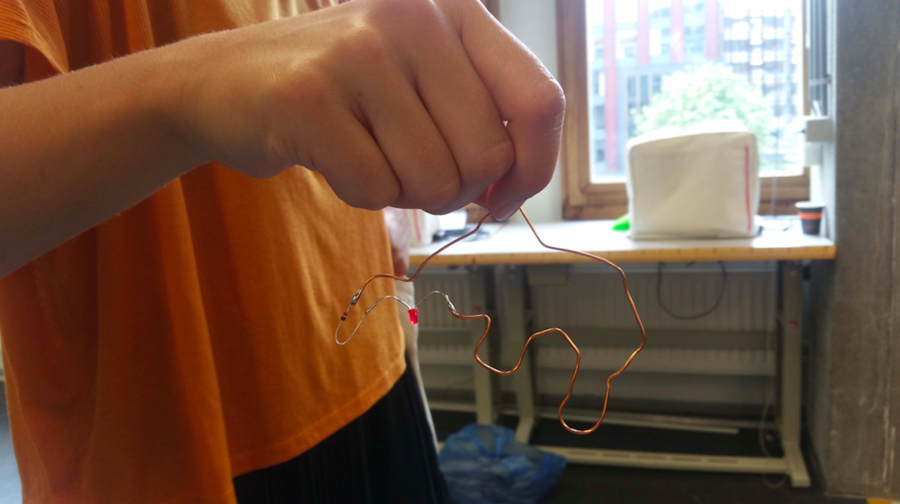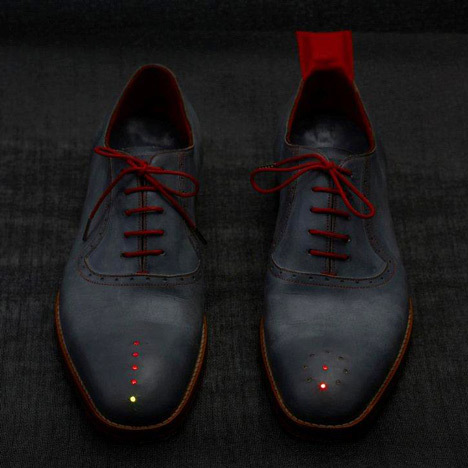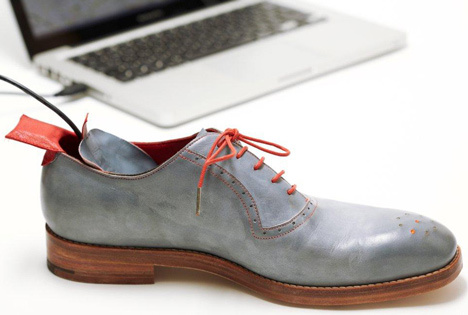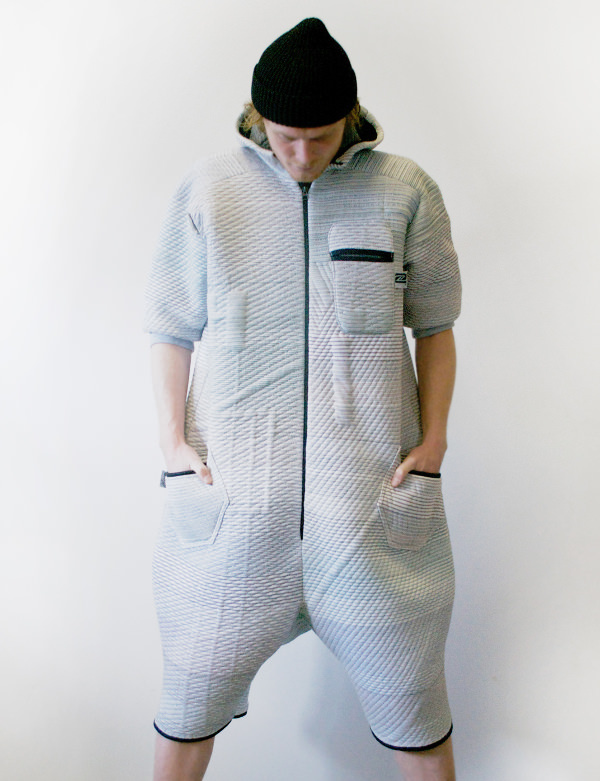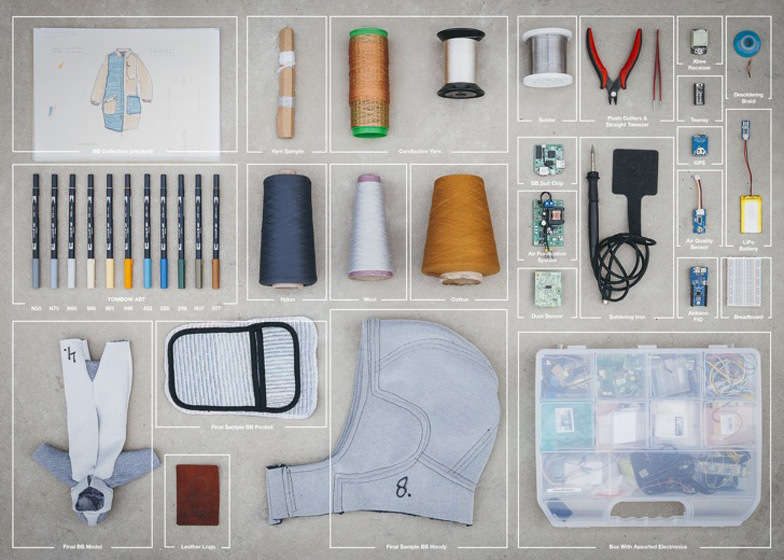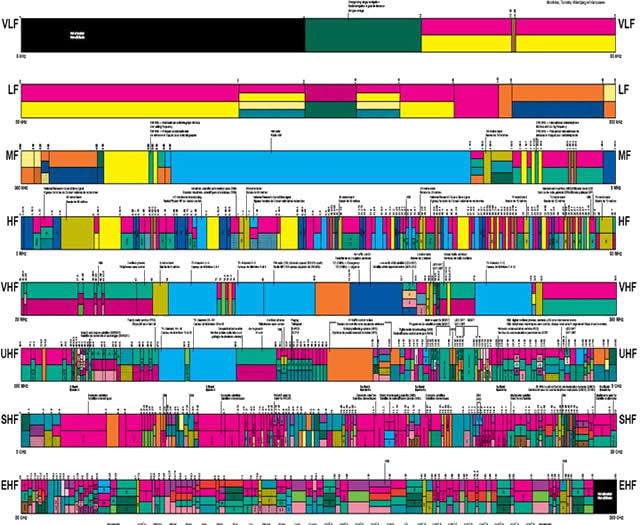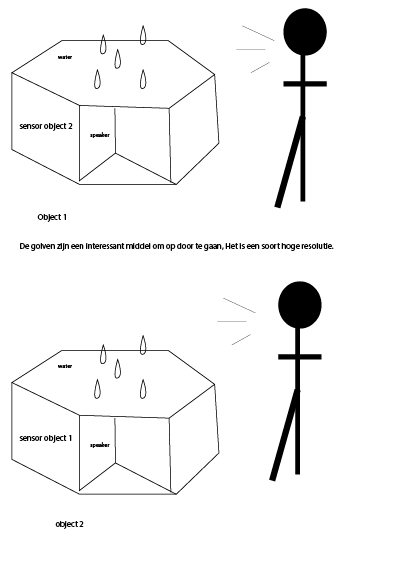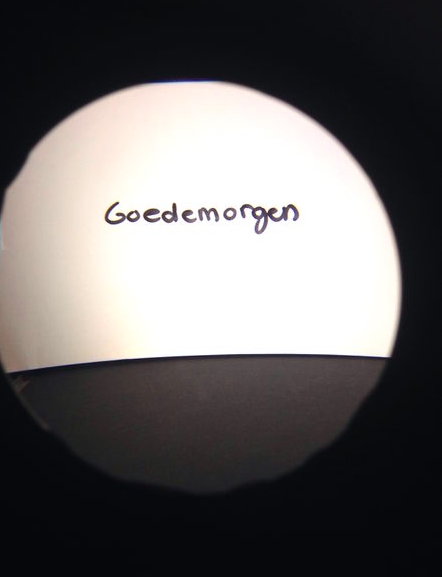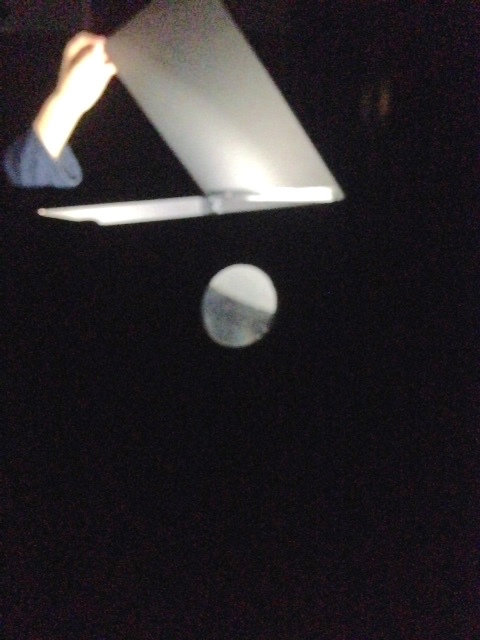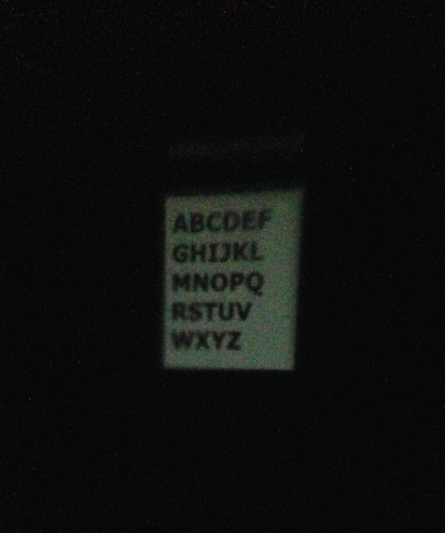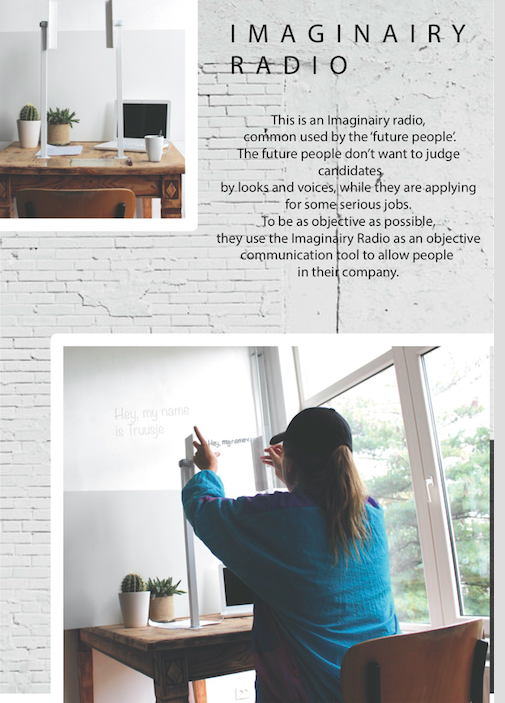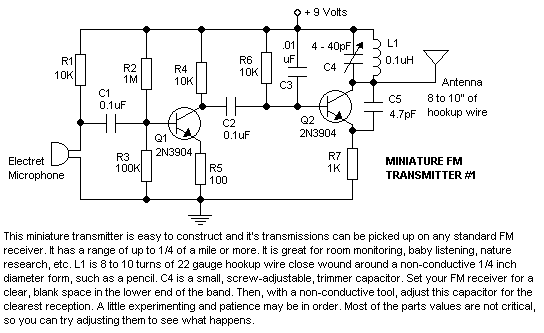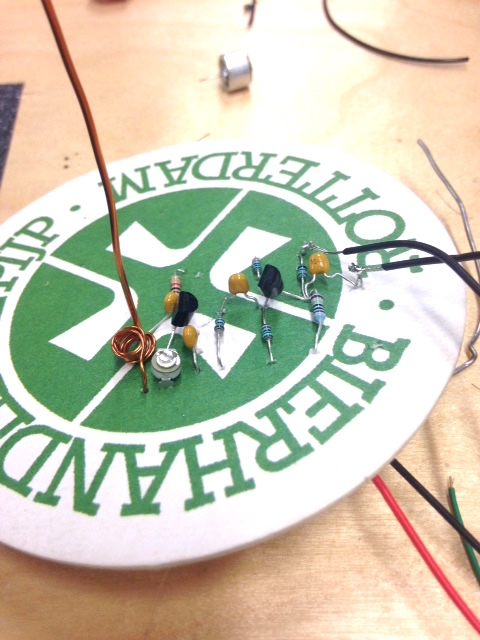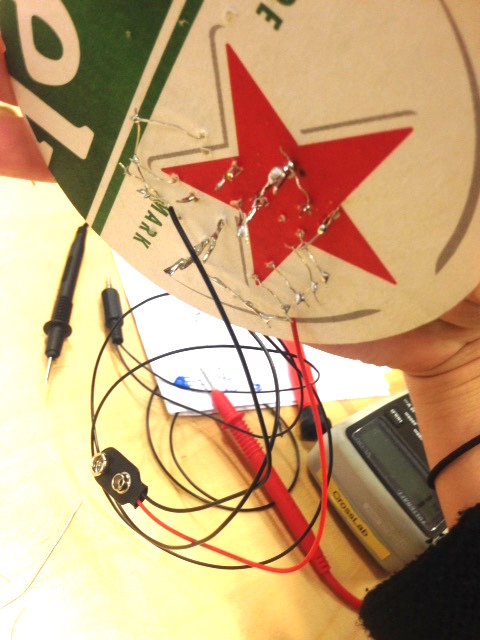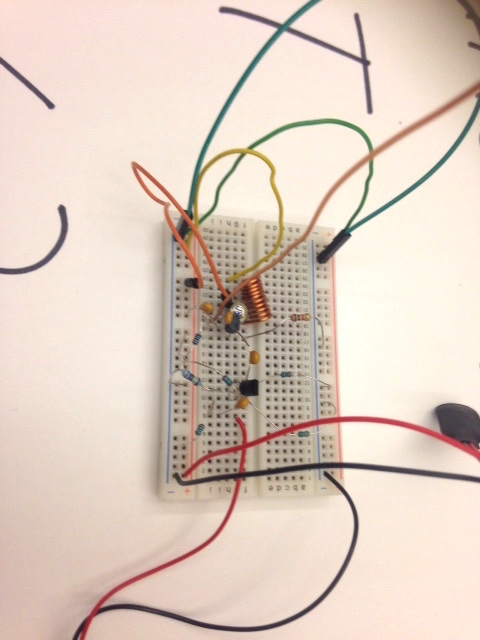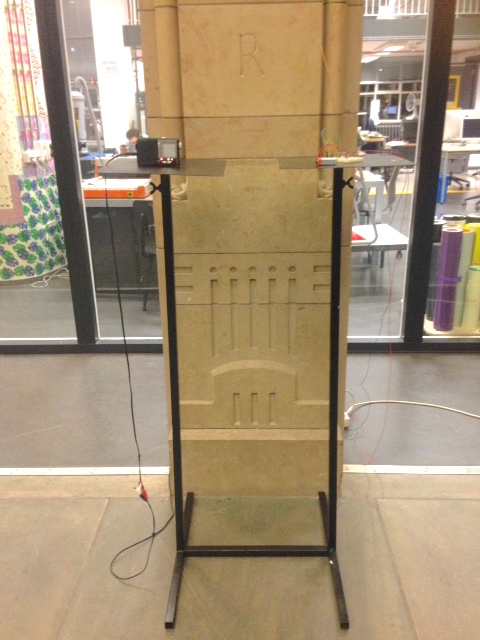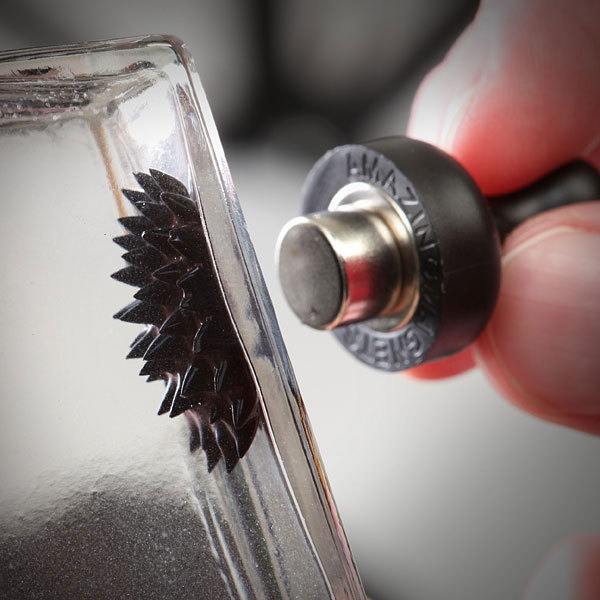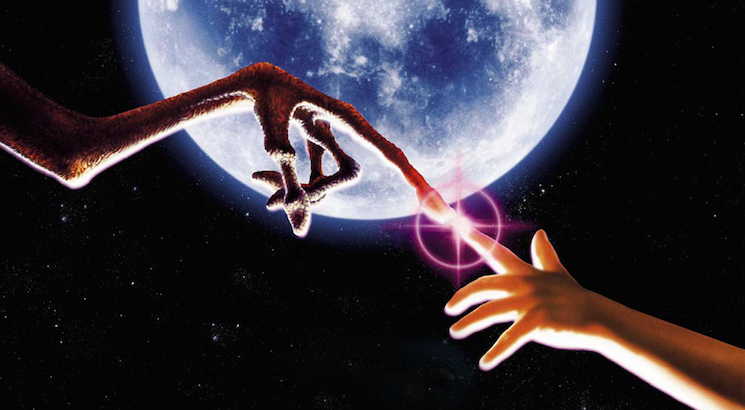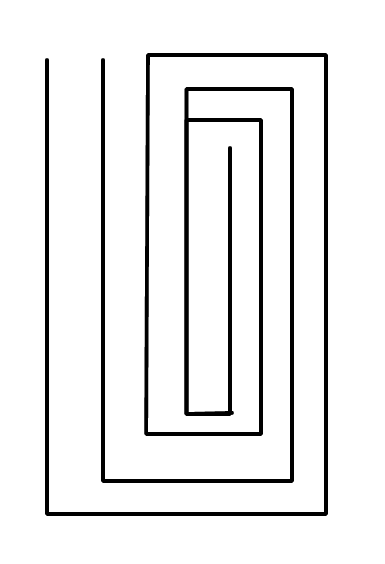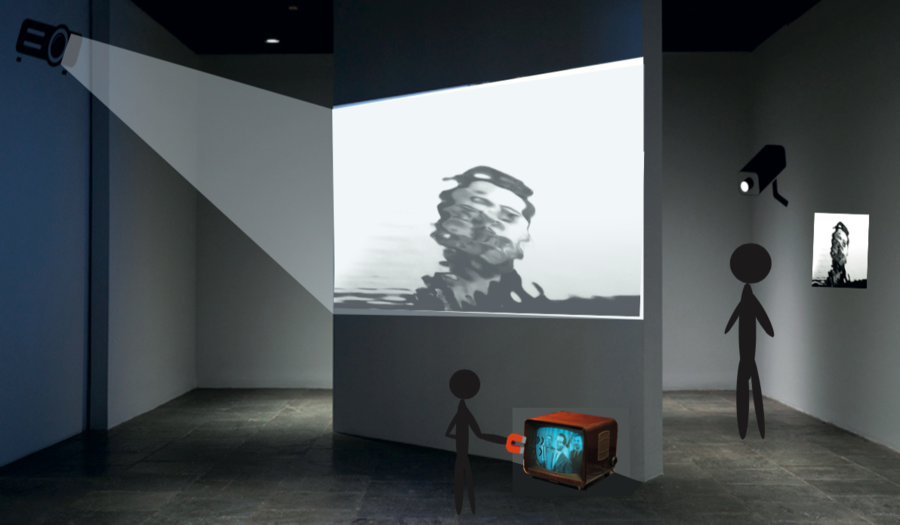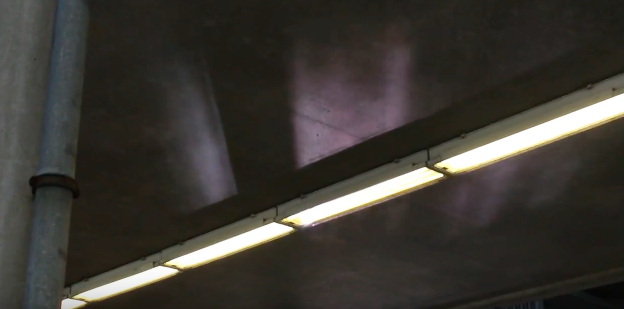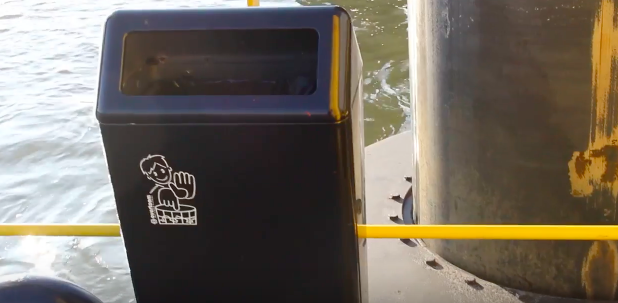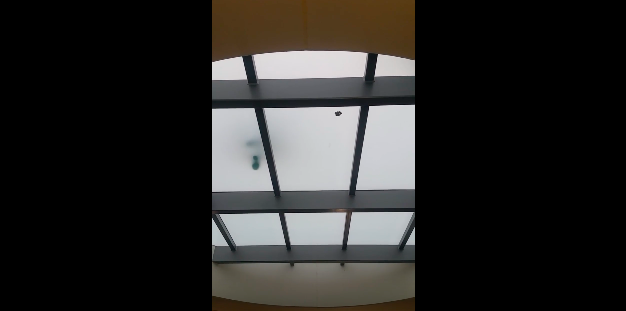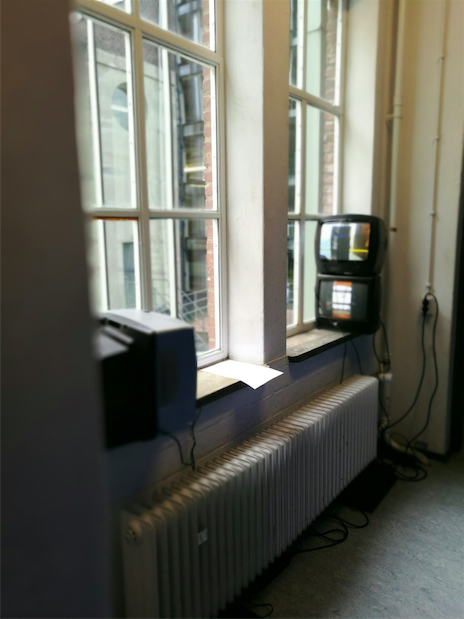User talk:Mimi
Q 9
Internal link: b.v: user:blabla of Main_page
pagina naam ontdekken? Achter het schuine streepje in de link staat de naam vermeld.
[ enkel
external link:
[[ dubbel
Youtube is also external link.
| = een streepje dat ervoor zorgt dat de text wel kan verschijnen in een internal link.
Bij een external link moet je gewon een spatie doen.
test pagina maken:
main_page/page_that_doesnt_exist
sub pagina:
Contents
Unravel the code introduction WIKI 2016/2017
smaller heading
heading without line
vier?
andere naam geven aan een pagina:
blablabjafahsfk
INTRODUCTION + WORKSHOP 1
During the introduction we got some basic information about Radiation. Explained by all the different teachers. The Minor students were showing their work to us, so we had a more clear idea of what it could be. We focussed a bit on GPS and WIFI signals the first class and how it can be influenced. During the workshop we were making an antenna. The antenna was a certain length(WIFI) to pick up GPS signals (wireless). We connected our antenna to a LED light. When we used Simon's phone to call, and turned it on the 2G network, we could see the light blink. It was really fun you could control a light just by the electro magnetic field. We made a creative shape of our Antenna. Here is the example:
EXAMPLES RADIATION IN FASHION
Dominic Wilcox
'No place like home' GPS shoes
These shoes are designed by Dominic Wilcox. He worked with LEDs in the toes that will guide you home no matter where you are. One of the No Place Like Home shoes has GPS technology embedded in the heel and an antenna in the red ankle tag. It communicates wirelessly with the other shoe. Custom-made software plots the location of home on a map before the data is uploaded to the shoe through a USB cable that plugs into the insole. The ring of LEDs in the left toe points the wearer in the right direction while those on the right toe show the journey's progress. "I had done a doodle about a month previously on my 'Sounds of Making in East London' record cover of a shoe with a switch on the front," Wilcox told Dezeen. "I think this was in my mind somehow, but I also thought about the Wizard of Oz and Dorothy's shoes to take her home. Mostly it was just an idea for a pair of shoes that I wanted to own myself," he added. Dorothy's red shoes are referenced in the red calf-leather lining, while Wilcox's illustrations of different homes are etched on the soles. Wilcox worked with technology expert Becky Stewart from Codasign and Northampton shoe makers Stamp Shoes. The project was commissioned by the Global Footprint project in Northamptonshire, an English county famous for shoe making. The shoes are being shown at Wilcox's solo exhibition during the London Design Festival.
.
BB SUIT
Dutch designer team: Borre Akkersdijk, Eva de Laat, Martijn ten Bohmer, Daan Spangenberg graphics.
Designed by Borre Akkersdijk, a Dutch textile developer, this prototype is basically the
opposite of the Jammer Coat because it is embedded with copper wires that enable WiFi, GPS, NFC and Bluetooth
that will turn you into a mappable hotspot with MP3 streaming capabilities. All those wires won’t hurt though
as there are two layers of cotton to protect the copper wires inside, thus making it comfortable to wear.
Interesting articles:
Digital and analogue signals
Electromagnetic radiation is used for communications and transmission of information. The waves that are used in this way are radio waves, microwaves, infrared radiation and light.
The idea of using a signal lamp to communicate was used in the 19th century. This method of long distance communication needed a code. One code used was Morse code, a series of long and short flashes of light for different letters of the alphabet. These signals can only be seen when visibility is good and for short distances.
Today we still use codes to send signals using electromagnetic radiation. There are two types of signal, analogue and digital. An analogue signal changes in frequency and amplitude all the time in a way that matches the changes in the voice or music being transmitted. A digital signal has just two values – which we can represent as 0 and 1.
An analogue signal varies in frequency and amplitude. A digital signal has two values, 0 and 1 (or ‘on’ and ‘off’).
wave communication The signal (voice, music or data) is converted into a code using only the values 0 and 1. The signal becomes a stream of 0 and 1 values. These pulses are added to the electromagnetic wave and transmitted. The signal is received and then decoded to recover the original signal.
Both analogue and digital signals can pick up unwanted signals that distort the original signal.
These unwanted signals are called noise. Digital signals can be cleaned up in a process known as regeneration because each pulse must be a 0 or a 1, so other values can be removed. Analogue signals can be amplified, but the noise is amplified too. This is why digital signals give a better-quality reception.
Digital signals give a better-quality reception because noise on digital signals is more easily removed.
This video shows an explanation of the differences between digital and analogue signals using CDs and vinyl records as examples. There are details of how each type of signal is generated to illustrate the differences between them, and the advantages of both types are also discussed.
Ebru Kurbak
[[4]]
WORKSHOP2:RTL-SDR experiments
During this workshop with Roel we got a lot of information about electro magnetic waves and how a radio works. We learned a lot about the electro magnetic spectrum. We also found out the difference between the FM and AM radio. And roel showed us a floor map from the radio spectrum inventory, which I found visually very inspiring (almost like a mondriaan painting).
Some notes during class: Signal frequency 1 hz is a wave length in 1 second. 2 hz is two wave lengths in 1 second. Kilo hz is thousand mega hz is million giga hz is million million The more hz the higher the sound will be. There was a nice video example in class of how this works. Doppler effect: when you are standing still and something passes by really fast, while making a certain sound, the sound will change. signal= a tone Fm= changes frequency
During this workshop we focussed on the RTL-SDR dongle. We needed to download the program GQRX and did some experiments with the RTL-SDR and pick up signals and sounds. I worked together with Seline in a team. It was hard at first to pick up signals. Our first challenge was to pick up signals from Radio stations actually this worked out really well. We did pick them up and it was all a very clear sound. We tried to make contact with planes, but this didn't work unfortunately. We followed some tutorials on youtube to try to get signals from planes, but we couldn't really figure this out. [[5]] We did later on pick up some random signals, but we can not really place them. We thought it were some noises from walky-talkies.
Back ground info about the term: There Hetzian space. Definition Hertzian space is a term used to describe a holistic view of the electronic device and its cultural interactions. Anthony Dunne and Fiona Raby[1] described this "electro-climate," inhabited by humans and electronic machines, as the interface between electromagnetic waves and human experiences. In a sense, Hertzian space is a holistic view of the electronic device and its cultural interactions. It has been defined by Anthony Dunne as the architecture of the physical interactivity between a device and a person.Everything that requires electricity gives off an electro-magnetic field that extends infinitely into space. Visible light is part of Hertzian space, as well as radio, medical X-rays, television signals and UV tanning lamps. While we only see the discrete object, there is in fact an entire wave-field emanating from the object.
Interaction with the natural and artificial landscape creates a hybrid landscape of shadows, reflections, and hot points". "Whereas 'cyberspace' is a metaphor that spatialises what happens in computers distributed around the world, Hertzian Space is actual and physical, even though our senses detect only a tiny part of the electromagnetic spectrum". "The new media and technologies by which we amplify and extend ourselves constitute huge collective surgery carried out on the social body with complete disregard for antiseptics", wrote McLuhan, "If the operations are needed, the inevitability of infecting the whole system during the operation has to be considered. For in operating on society with a new technology, it is not the incised area that is most affected...It is the entire system that is changed".
Dunne and Raby believe that increased awareness of Hertzian space will assist our design practices. They think that we are only beginning to understand the effects and consequences of technological advances, and that "it is an environment that must be fully understood if it is to be made habitable".[5] By thinking about technologies in terms of Hertzian Space, we gain a more holistic understanding of technology that goes beyond the merely visible technological object and encompasses the practices, economics, and ideologies that become encoded into technological artifacts.
WORKSHOP3:The 1st imaginary Radio assignment (brainstorm):
[[6]]
During this workshop we did some research into the history of radio. We also researched the radio from the morse code period. An interesting form of radiation. It is super analogue, but clearly the same function as a radio. We were divided in groups and we had to make a small concept and project/prototype about our concept. I was in a group with Merle, Veerle. We thought about something as a morse code to work with. We came up with an sound/water system. Communication through water was the idea. After we made our concept clear, the concepts switcht around and we had to implement a concept of another group. The concept of the other group was a 'skype' kind of idea combined with history and life presentation. We came up with the idea to show an old video from Rotterdam in the 1920's and combine this with life sounds from the streets in Rotterdam. I went outside with my phone and i called Merle, while she was in the presentation room, where the video was played. We connected the phones to speakers, so you could hear the sounds really well. It worked out really well. The other presentations were also very inspiring to get ideas from what radio also could be. Eventually we needed to work on this farther. The assignment was to come up with an imaginary radio.
Imaginary Radio:
For this assignment we needed to work in Duo's. So I chose Seline as my partner. We needed to make a form of communication with a big influence on people, culture, way of thinking etc. We needed to make a scenario for our imaginary radio idea.
First we did some brainstorming. We thought of doing something with light, reflection, electro magnetic waves, materials that can influence the electronic magnetic waves etc. Eventually we got inspired by the morse code and the analogue side of it. For this assignment we tried to keep it some kind of analogue for the prototype.
We came up with an idea for an job interview. We wanted to make the dialogue as objective as possible by letting the conversation happen through a wall and without hearing/seeing each other. The communication would happen trough a projection. Of course people can judge each other then on hand writing (there is almost always something to judge). But the most important thing for us was taking away all accents and looks where people are often rejected by during a job interview. We thought of developing it later on with adding some character to it and also putting away the handwriting maybe by making it more digital.
To test this idea we had to implement it with a prototype. At first we wanted to make a projector by ourselves. It worked out pretty well actually, but we found out during the tests that we could rather use another more simple technique: A transparant sheet, you could write on. You could use your phone to send the message by turning on your flashlight and point it behind the sheet. The text was much clearer then through the projector.
Source of the tutorial we used for making the projector: [[7]]
Projection with hand writing.
Projector itself.
Projection through mobile phone.
We also made a setting plus prototype of this idea and finally an A-3 poster. This is what our new prototype looked like:
WORKSHOP4:Collaboration with the MICA Students
Project: PIRATE RADIO
For this workshop we worked together with MICA students. We were divided in groups and had to work the whole day on an exciting project. At first I thought it was really hard to realize it, but eventually we made it. Within our group we devided people in 'transmitter makers' and in 'concept makers'. I preferred the 'transmitter makers' group, because I was curious about this part I didn't really knew about. I was in a group with Maaike and Sanne. They already did something like this before, which was nice because I learned a lot from them. We started with a sketch/floor map from the construction of the transmitter. The sketch looked like this.
We needed to connect the elements together in the right way.
The first few tries failed for a couple of reasons.
Sometimes things were not soldered properly,
or sometimes elements were aborted.
Then we had to find out where the problem was.
By reading the floor map again we could figure out what it was.
After a couple of tries we finally got a working transmitter, which was super exciting. When we tuned to frequency 88 FM, their was a strong signal from our transmitter. We plugged it in our phone and played a song. When we tuned the radio to the right frequency, we could hear the song on the radio.
This was what the transmitter looked like
The other side
Our transmitter worked for about 4 times, but we might have to use a better one, when we heard what the concept was of our group.
Concept:
Pirate Radio:
Micro radio stations have a long history of connecting people within communities, often serving as platforms for talk shows where people can call in to a host with their personal questions. With the creation of the Internet and the consolidation of information, people are increasingly turning to online search engines to answer their most personal questions. These platforms provides individuals with the feeling that they have been heard, without human interaction. Pirate Radio aggregates the most frequently asked Google search questions, responding to them using the Rogerian Method ( a psychotherapy technique that answers questions with questions). Micro radios' legacy included answering questions posed by community members. What does it mean when a bot answers frequently Googled questions?
Now that we had a concept and a transmitter ,we were preparing the presentation in the hall of Blaak.
I quickly hired some speakers to make the sounds louder.
When we were testing the transmitter out for the last time, we came to the conclusion that it didn't work out really well.
Thanks to the help of Yoana we got a better one. It looked like this
When we had this much stronger transmitter our plan worked out really well.
We connected the transmitter to the computer where the Eliza program was open and replied to the other groups questions.
Eventually we didn't use the speakers anymore, because it worked out on the radio as well.
It was super exciting to hear the robot dialogue on the radio.
It was the same frequency as we used before: about 90/88.
Our final presentation was the next morning.
CONCEPT IMAGINARY RADIO
First ideas:
‘Interessante spontaniteit in een anonieme vorm van communicatie, die je in een niet-anonieme vorm nooit zou kunnen ervaren.’
[https://www.youtube.com/watch?v=vsQh1AT6qUE
Idee:
-Muur schaduw sensoren, communicatie via aanraking’. -Proef: pixels. -Testjes schaduw sensoren en LED -Magnetische muur communiceren met magnetische handschoenen.
Seline and I had the concept with the job interview at first. But we wanted to do something else, something that would interest us a little bit more.
We liked the previous Idea with the wall and the communication through a wall, without knowing what is behind it.
It could be basically anything, also something fictive.
We were brainstorming about something that could symbolize the touching of something 'unknown'. We immediately thought of a few science fiction movies and series we've seen.
It's almost a common thing within science-fiction stories to let different species meet each other through a touch by hands/fingers.
We thought this was an interesting out come to do a concept with.
What we know about science fiction is that it is a lot in a certain style that could be a nice factor within our project. We looked some science fiction movies and comics up, to get an idea of the visual image of science fiction.
We also looked for some inspiring artists who already did something with this type of 'wall communication'. You can find the examples at Seline's page.
Eventually we thought of making a communicating wall/ maze. We wanted to make a maze as a symbol for trying to reach another dimension. You know there is a way, but the way to it is hard to find but it's not impossible to reach the other world.
The maze will be from textile. You can't really touch each others skin by skin but experience the presence of each other by seeing silhouettes through a textile wall. When you get closer or touch the wall, the silhouette will change. You communicate trough touching the wall. On one the hand trough analogue communication, on the other hand trough digital communication.
Analogue by changing the colors of the maze by hand and digital trough light sensors (lighting up when someone gets close). Here is a floor map from our installation:
We wanted to make the maze analogue and digital, because we wanted to show a big contrast to those two, but also a common element. In science fiction there is in general almost an exaggerated form of non technical humans and high tech unknown creatures. We wanted to combine these elements also in our maze.
.
Q 10 CLASSES
Questions:
Mirthe:
'1. What theme are they investigating? ' Science fiction, anonymous communication through light sensors.
2. What would be an appropriate question/challenge to answer in this project?
What are you going to communicate?
3. Name an interesting reference project that has yet to be mentioned (what does this work remind you of?)
See page Seline.
4. In what context do you forsee the final result situated in (commercial product/service, gallery object/installation, public intervention, experimental publication…. ? Installation in a gallery.
Installation
5. What weakness or threat should be urgently addressed?
The threat is that the project is to big and to hard to realize.
6. What would you propose as a logical next step?
I think investigating the fabric, lasercutting techniques for the analogue part of the maze and also making a small prototype of the maze and the light sensors.
7. What might you be able to offer in terms of expertise/common interest that could be potentially useful for this project.
?
8. How does/could the project connect with radio / electromagnetic spectrum?
By communicating truth light and analogue Mors code inspired technique.
aantekeningen:
3 Verschillende dingen uitproberen. Je kunt veel kanten opgaan met bijoorbeeld een gevoel wat je krijgt door de communicatie. Wordt de communicatie betekenisvol? Duidelijk? Eng kan ook een toegevoegde waarde hbben.
Sanne
1. What theme are they investigating?
Receiving Images through radio waves.
2. What would be an appropriate question/challenge to answer in this project?
How to capture/collect this images?
3. Name an interesting reference project that has yet to be mentioned (what does this work remind you of?)
Michelle Teran – 17 Cities (Peek-a-Boo) Benjamin Gaulon – 2.4 Ghz CCTV Hacking
4. In what context do you forsee the final result situated in (commercial product/service, gallery object/installation, public intervention, experimental publication.
She will make a camera that receives this images and scan them. The collection of images can be part of an experimental publication/exihibiton
5. What weakness or threat should be urgently addressed?
That it has too function like a camera: portable(or antenna), videoscanner. Will security camera’s still work on 2.4ghz?
6. What would you propose as a logical next step?
Experiment with a monitor and a antenna. Can you receive something?
7. What might you be able to offer in terms of expertise/common interest that could be potentially useful for this project.
Conceptual wise add some value to the images for example.
8. How does/could the project connect with radio / electromagnetic spectrum?
These images are transfers through radio waves.
aantekeningen:
Interessant security camera’s, Iedereen kan iedereen zien.
Jeroen 1. What theme are they investigating?
The reaction of a monitor manipulated by magnets, changing the grid of a monitor. Processing images by electro magnetic distortion.
2. What would be an appropriate question/challenge to answer in this project?
How far can you manipulate the grid? Can you send out a message for example? How can you take this farther conceptually?
3. Name an interesting reference project that has yet to be mentioned (what does this work remind you of?
June Paik, inspiring. A lot examples with monitors.
4. In what context do you forsee the final result situated in (commercial product/service, gallery object/installation, public intervention, experimental publication…. ?
Interactive gallery object/ public installation.
5. What weakness or threat should be urgently addressed?
Jeroen would like the magnets to be in the monitor. How can it be implemented in the monitor? Technically.
6. What would you propose as a logical next step?
Experiment. Try what happens, what visual can you get? And develop the concept a little bit more. Making a small prototype.
7. What might you be able to offer in terms of expertise/common interest that could be potentially useful for this project.
Conceptual wise help to develop it a little more, experiment.
8. How does/could the project connect with radio / electromagnetic spectrum?
ages affected by the electromagnetic spectrum.
aantekeningen:
Beweging, afbeelding veranderen.
Experimenteren hoe deze images reageren.
Wat betekent dit?
Search for quietness?
Wat kun je plannen om te doen.
Nina 1. What theme are they investigating?
Visualization of sound/pixels
2. What would be an appropriate question/challenge to answer in this project?
How to make clear that sound distorts the face
3. Name an interesting reference project that has yet to be mentioned (what does this work remind you of?)
Pixelated portrait
4. In what context do you forsee the final result situated in (commercial product/service, gallery object/installation, public intervention, experimental publication.... ?
Gallery, Public intervention
5. What weakness or threat should be urgently addressed?
To make it more specific
6. What would you propose as a logical next step?
Explore and focus on how to visualize more specifically the distortion
7. What might you be able to offer in terms of expertise/common interest that could be potentially useful for this project.
Software knowledge
8. How does/could the project connect with radio / electromagnetic spectrum?
Two devices act one as a transmitter the other as receiver.
Aantekeningen:
Selfie. Conceptueel toeveogen. Een image maken wat herkenbaar is voor het publiek. Verschillende situaties toevoegen. Boris vragen om te kunnen experimenteren.
Ik moest tijdens deze les een concept bedenken voor Jeroen. Uiteindelijk heb ik dit bedacht:
LIFE MAGNETIC PHOTOSHOP Omdat bijna alles tegenwoordig gephotoshopt is/ filters heeft, weet je niet meer hoe iemand er echt uitziet, waar iemand zich bevindt etc. Manipulatie van de achtergrond, uiterlijk en filters zorgen ervoor dat bijna niemand meer ‘echt’ op de foto staat. Er is bijna altijd wel iets gebeurd aan selfies tegenwoordig. Denk bijvoorbeeld aan snapchat waarbij je life een filter/ photoshop effect kunt realiseren. Mensen willen allemaal mooier en grappiger op de foto staan. Maar stel dat iemand anders dit in handen heeft? Wat gebeurd er dan?
Idee:
Een life webcam filmt iemand in een bepaalde ruimte.
In een andere ruimte staat een monitor met de lifestream van de persoon in de andere ruimte.
Degene in deze ruimte kan met magneten het uiterlijk/effecten van het beeld manipuleren.
Degene bij de webcam ziet direct de effecten en neemt op deze manier waar wat er
verandert wordt aan het uiterlijk d.m.v. de magneten.
Hieronder is een schets te vinden van hoe het er ongeveer uit zou komen te zien:
Bij de lessen die hierop zouden volgen, moesten we per groepje iemand aanwijzen die onze projectleider werd voor die dag.
We gingen met zijn alle aan het werk voor een iemand zitten om diegene verder te helpen.
Jeroen was de eerste die aan de beurt was. Hij wilde iets met een monitor doen en magneten. Hij wilde bepaalde effecten bereiken op de monitor, doormiddel van gebruik van magneten. Ik ben toen opzoek gegaan naar een monitor en heb met kleine hardeschijf magneten het een en ander uitgeprobeerd. Zie hier het voorbeeld:
Q10 PROJECT
Toen we onze feedback kregen over ons concept dit kwartaal, kregen we te horen dat het misschien vereenvoudigt moest worden. Het kon iets teveel gaan neigen naar een attractie/spookhuis. Hier waren we het uiteindelijk wel mee eens. Ik denk dat we wel iets moois neer hadden kunnen zetten, maar gezien de tijd zou het misschien niet haalbaar zijn.
Allereerst waren we beide enthousiast over het gebruik van een lichtsensor. We hadden deze al een keer op een eenvoudige manier met makey makey samengesteld. Dus nu wilde we een circuit solderen en kijken of het werkte. We hebben het een aantal keer opnieuw moeten doen, maar uiteindelijk is het ons gelukt. We hebben het circuit later aangesloten op een 'echte' lamp i.p.v. een LED en dit werkte ook. Zie hieronder de proces foto's en het resultaat:
(FOTOS LAMP PROEVEN SELINE)
We besloten om verder onderzoek te verrichten.
Voor onze herkansing moesten we ons onderzoek uitbreiden. Dit hebben we gedaan doormiddel van:
- Het bestuderen van 8 locaties, waarbij een bepaalde aanwezigheid voelbaar is
- Het uitvoeren van 3 experimenten met: geluid, licht en beweging.
VERVOLG ONDERZOEK
8 LOCATIES EN SITUATIES
1. Beweging prullenbak: Interessant dat de prullenbak trilt doormiddel van een geluid. Simpel object. Interessant om op door te gaan. Idee: geluid uit de prullenbak (uit de context halen).
2.Lichtbron van iets onbekends. Niet wetend waar iets(projectie) vandaan komt.
3.Schaduw Je ziet de aanwezigheid, maar geen gedaante.
4.Geluid Tegel:
Onverwacht geluid wordt gecreëerd.
Uiteindelijk hebben we veel verschillende locaties vastgelegd.
Hieronder nog een aantal voorbeelden:
Onverwachts geluid:
schaduw:
[13]
Voetstappen: [14]
3. Beweging?
Onverwacht object wat spontaan beweegt.
.
3 EXPERIMENTEN
1. geluid
2. licht
3. beweging
1. Geluid experiment:
Voor dit experiment hebben we gebruik gemaakt van een speaker. We hebben deze op verschillende locaties uitgeprobeerd en met verschillende geluiden.
We wilde het volgende weten:
-Hoe reageren mensen op bepaalde geluiden?
-Voelen ze een aanwezigheid door een bepaald geluid?
-Gaan ze gedrag vertonen door een bepaald geluid?
Verschillende geluiden die we hebben uitgeprobeerd:
-Telefoon die afgaat
-luidspreker
-kloppen
-brekend glas
-schreeuw
We hadden de speaker in eerste instantie in de papierbak gedaan, om te kijken wat het effect zou zijn als mensen er iets in zouden gooien en er een totaal ander geluid uit zou komen. Dit experiment was geslaagd. Later gingen we het geluid zomaar afspelen, zonder acties en dit zorgde ervoor dat mensen gingen zoeken naar de bron van het geluid. Mensen wisten niet waar het vandaan kwam en gingen gokken waar het vandaan zou kunnen komen. Dit is ook te zien in onze filmpjes.
(filmpjes Seline)
Wat vonden we het meest interessant aan de geluid experimenten?
- Het onwetende van het publiek, waar het vandaan kwam en wat het precies was.
- Mensen waren verrast dat het uit een raar object kwam.
- De kettingreactie die het kan veroorzaken. Als een iemand het opmerkt, merken anderen het ook eerder op.
- Een kloppend geluid zorgt voor de meeste reactie. Waarschijnlijk omdat het een schijnbaarder geluid is en een communicatiemiddel.
Een kloppend geluid, zorgt vaak voor een automatische reactie van opkijken, omdat je weet dat iets of iemand met je wilt communiceren.
2. Licht experiment. Voor dit experiment wilde we weten hoe mensen reageren op licht dat spontaan aan gaat op een plek waar mensen het niet verwachten. Hiervoor hebben we gebruik gemaakt van een laserlampje. Op deze manier wilde we onze aanwezigheid door laten schemeren naar een ander gebouw/omgeving. Voelen mensen zich gezien? Voelen ze zich bedreigt? We wilde bij dit experiment de reacties van mensen bestuderen wanneer ze niet weten waar iets vandaan komt, maar er iets is dat hen wel waarneemt.
Wat zijn onze bevindingen? Dit experiment pakte niet heel goed uit. Sommige mensen reageerde niet. Anderen reageerden geïrriteerd. Mensen waren niet erg onder de indruk van de aanwezigheid van de laser. Hetzelfde deden we met een reflectie, maar dit pakte ongeveer hetzelfde uit.
3. Bewegings-experiment.
Voor dit experiment hebben we gebruik gemaakt van een poster en een magneet.
We hebben zelf verschillende posters gemaakt:
-met de tekst: Who am I?
-ogen
Op deze manier wilde we de letterlijke communicatieve kant bestuderen, en de nieuwsgierigheid van mensen en wat voor effect dit zou hebben op het publiek.
Ook wilde we mensen een extra gevoel van aanwezigheid geven door de beweging van de poster.
Wat zijn onze bevindingen? Sommige mensen reageerden erg verbaast en nieuwsgierig. Ze waren niet bang, maar wilde wel weten hoe het kon. Sommige gingen achter de poster kijken om te kijken of er iets achter zat. Maar heel veel anderen liepen door. Kortom niet echt succesvol het gaf ons eerder een soort prank gevoel. Zo zagen de posters eruit:
(afbeeldingen verschillende posters)
Wat was het meest interessant aan dit experiment?
De nieuwsgierigheid van de mensen. Het willen weten wat er achter de poster zit. Dit deed ons erg denken aan ons allereerste concept met de muur. Door een beweging heb je een gevoel van aanwezigheid en vooral door het feit dat een 'gewoon' object spontaan beweegt. Wat normaal gesproken niet zou 'kunnen'. Doordat het object uit de context gehaald wordt, raken mensen getriggerd en willen ze weten hoe iets zit. Toch viel de reactie over het algemeen tegen.
conclusie van ons onderzoek:
Tijdens dit onderzoek zijn we erachter gekomen, dat de reactie die we soms verwachten totaal niet gebeurd. In eerste instantie lijken dingen vanzelf sprekend maar dat zijn ze niet. Bepaalde experimenten hebben ons erg verrast. Door spontaan door de stad te lopen kwamen we snel op ideeën voor locaties, waarbij een aanwezigheid voelbaar is. De uitvoerende experimenten met geluid etc. Vonden we het sterkst. Geluiden zorgen voor de meeste aandacht. Zeker als het ergens vandaan komt waar mensen het niet van verwachten. Ook kun je automatisch gedrag aanwakkeren door bijvoorbeeld bepaalde geluiden. We kwamen erachter dat toen we communicerende sound effects gebruikten, mensen eerder geneigd waren op zoek te gaan naar de herkomst van het geluid.
Nieuwe Ideeën:
-Een muur met servies laten trillen, d.m.v. frequenties van een lage bas toon.
Hoe dichter iemand de muur nadert aan de ene kant, hoe sterker de trillingen/bas aan de andere kant.
-Meerdere objecten in een ruimte benutten om verschillende geluiden uit te laten komen.
Mensen op deze manier een gevoel geven van een bepaalde aanwezigheid,
zonder dat ze weten waar het geluid vandaan komt, omdat meerder objecten benut worden.
(klopgeluiden, aandachttrekkende/communicatieve geluiden)
-Projectie, manipulatie van een bepaalde aanwezigheid. (voetstappen)
-Wand met magneten
Brainstorm:
Wat vonden we interessant aan ons onderzoek?: 1. de tegel waar we onverwacht van schrokken, ondanks dat het een super normaal object is in de context. 2. De bewegende prullenbak vonden wij interessant vanwege het gevoel dat er een aanwezigheid is in het object. 3. Geluidsonderzoek: mensen zoeken naar de bron van het geluid en zijn in de war. Willen het geluid opzoeken en willen weten wat het is.
Deze elementen willen we samenvoegen voor ons project.
Ideeën:
1. Tegel/banaan op straat waar een geluid vanaf komt wanneer je er op stapt. 2. Object op straat waar al geluid vanaf komt, maar zodra iemand nadert wordt het geluid versterkt. 3. Serie van verschillende objecten en geluiden maken en deze vastleggen met film. 4. Muur met service, met een speaker erachter die luider wordt wanneer iemand aan de andere kant van de muur nadert. 5. Random geplaatste sensoren en lampen in een kamer, waardoor verwarring ontstaat en het gevoel van een bepaalde aanwezigheid doordat de lampen aan gaan.
We kregen verschillende ideeën, vooral op het gebied van objecten. Tijdens het onderzoek zijn we tot de conclusie gekomen dat ons concept redelijk ver van science fiction was verwijderd We kozen ervoor door te gaan op de uitkomsten van ons onderzoek en een nieuwe conclusie/concept hieraan te linken. De uiteindelijke basis voor ons concept werd: 'Een vorm van onbekende/anonieme communicatie aanduiden. Niet wetend wie of wat er met je communiceert, maar een vorm van communicatie die er onbewust/bewust wel is.'
We wilde een vereenvoudigde communicatie gebruiken, die op het eerste oog voor veel mensen niet te ontcijferen is.
Dus geen gebruik maken van standaard woorden of alfabet.
We dachten aan verschillende vormen van communicatie zoals: -morse code -binary code
We kozen voor de Binary code.
Binary code We vonden deze manier van communicatie interessant, omdat je niet weet of je nu communiceert met een mens of een object/ computer of zelfs een wezen van buitenaf. Tegenwoordig is de technologie zover, dat computers zichzelf kunnen programmeren. Mensen begrijpen de binary code vaak niet. Dit vonden we interessant voor ons concept, omdat het echt gaat om een ontcijfering en er een grote vorm van anonimiteit binnen deze vorm van communicatie is.
Woorden die we wellicht interessant vonden om in ons ontwerp te verwerken zijn: -anonymous 01100001 01101110 01101111 01101110 01111001 01101101 01101111 01110101 01110011
-?
00111111
-Who am I? 01010111 01101000 01101111 00100000 01100001 01101101 00100000 01001001 00111111
-Communicate
01100011 01101111 01101101 01101101 01110101 01101110 01101001 01100011 01100001 01110100 01100101
-Answer
01100001 01101110 01110011 01110111 01100101 01110010
-Question
01110001 01110101 01100101 01110011 01110100 01101001 01101111 01101110
-Hello
01101000 01100101 01101100 01101100 01101111
-Unravel
01110101 01101110 01110010 01100001 01110110 01100101 01101100
-Code
01100011 01101111 01100100 01100101
FEEDBACK MOMENT JOHN 17 JANUARI:
Tijdens ons onderzoek naar aanwezigheid kwamen we tot de volgende conclusie. Aanwezigheid is heel vaak een bewuste of onbewuste vorm van communicatie. Dit gingen we onderzoeken door bijvoorbeeld locaties op te zoeken, waarbij een vorm van aanwezigheid voelbaar was en 3 verschillende experimenten uit te voeren, waarbij we de reactie van mensen onderzochten op de onderdelen: 1. Geluid 2. Licht 3. Beweging Aanwezigheid is iets wat vooral merkbaar was wanneer iets passeerde. Wij konden verschillende gedaante/objecten/voertuigen aanvoelen door bijvoorbeeld: Geluid, licht, schaduw of beweging.
Hierop kregen wij de volgende feedback:
1.Keuze maken in welke vorm van aanwezigheid je wilt laten zien:
-Eigen aanwezigheid/waarneming
Door jouw eigen aanwezigheid neem je bepaalde dingen waar die in een ruimte gebeuren.
-Iemands/iets aanwezigheid Je voelt een aanwezigheid, doordat je bepaalde dingen waarneemt die kunnen suggereren dat er iemand is.
-Kunstmatige aanwezigheid. Er wordt een idee gegeven dat iets/iemand zich bevindt in een ruimte, wat niet zo is.
2. Goed de video’s als inspiratie gebruiken (misschien samenwerken met het werk).
-Niet alles in een ding proppen
-Waar juist weinig gebeurd en veel focus is, is het interessant.
-Goed nadenken of het een kledingstuk moet zijn of niet.
-Signals (analogue) belangrijkste woord.
-Bijvoorbeeld lap stof waar iets achter beweegt.
Ideeën die we vervolgens hebben bedacht: 1. Onze filmpjes zijn een goede basis geweest voor ons project. Seline en ik liepen gister onder een lantaarnpaal die knipperde, dit deed ons erg denken aan de filmpjes die we voorheen gemaakt hadden. Het gaf ons een gevoel van aanwezigheid/signals en iets dat met ons wilde communiceren. We zochten op youtube een filmpje op dat overeenkwam met onze ervaring: [[15]]
We kwamen hierdoor op het idee te gaan werken met aanwezigheid van anderen in een ruimte. Wij leggen iemand een bepaald gevoel op, waardoor zij voelen dat er iets wil communiceren met hen. We bedachten om een abstracte versie te maken van de lantarenpaal die we de dag ervoor gezien hadden. Ook willen we het uitvoeren in de publieke ruimte. Omdat we een spontane communicatie willen creëren tussen verschillende mensen, willen we er 2 uitvoeren die met elkaar samenhangen. Zo komt ons eerste concept weer een beetje naar boven met de muur en de sensoren.
2. Een lap stof registreert de voorbijgangers. En vertaald deze naar lichten. De stof is van een reflecterend materiaal, waardoor de aanwezigheid/signals beïnvloed worden door de omgeving. Hierdoor wordt de aanwezigheid, verdubbelt, geprojecteerd,vervaagd en vanuit verschillende perspectieven zichtbaar. Mensen worden zich hierdoor bewust van aanwezigheid.
FEEDBACK ROEL 24 JANUARI:
Maak het minder gemaakt, spontaniteit,
Misschien moet het niet een kledingstuk of eindproduct zijn, maar een collectie/verzameling van de beelden die jullie al hebben.
Maak een aantal ideeën van hoe je het zou willen presenteren,
Eventueel extra filmpjes maken. Alledaags moet niet op een bijzondere manier gepresenteerd.
Iets wat niet opvalt, netjes gedocumenteerd.
Bundelen,kijken naar werk van helmut Smits.
Toen we onze feedback ontvingen van John en Roel, kregen we te horen dat onze video's tijdens het onderzoek al heel waardevol waren. Er was een bepaalde puurheid/spontaniteit, waar we naar zochten al ontstaan tijdens het onderzoek. Het onderzoek was eigenlijk al een product van ons concept. We hebben veel gebrainstormd over ontwerpen die zouden kunnen voortvloeien uit de filmpjes, maar we vonden de filmpjes toch iedere keer te waardevol en het concept al heel duidelijk d.m.v. wat we al hadden. We hebben besloten de filmpjes als ons eindproduct te gebruiken en goed na te denken op welke manier we de filmpjes konden presenteren, zodat je het bijna hetzelfde gevoel zou krijgen als dat het live zou gebeuren. Eerst dachten we aan een hele simpele presentatie. De filmpjes naast elkaar als een soort collage afspelen. We vonden het idee van een kleine collectie interessant, maar we vonden een simpele projectie niet passen bij ons concept en het gevoel wat we wilde meegeven. We besloten het meer een puur gevoel te geven.
Doormiddel van oude Tv schermen naast elkaar te zetten en deze tegelijkertijd af te spelen, krijg je sowieso een gevoel van iets waarnemen wat jou niet ziet (denk aan bewakingsvideo's). Ook vonden we het gebruik van tv monitoren goed passen, omdat we tijdens het onderzoek iedere keer uitkwamen op de meest alledaagse voorwerpen, die er juist voor zorgden dat het geheel interessant werd.
Zie hieronder de video's die we hebben uitgekozen:
Final result of the installation:
